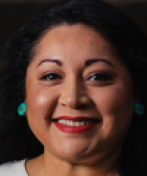
- Details
- By Local Media Association Staff
Native American Heritage Month runs from Nov. 1- Nov. 30, recognizing Indigenous peoples past and present who have positively influenced and enriched the United States. This month, we spoke to leaders at 4 news organizations that serve Indigenous audiences to find out how they connect with their readers, what fuels their passion for journalism and how they stay competitive in the digital and print news market.
This story was orginally published by Local Media Association. Used with permission.
Mvskoke Media
What is one product or innovation that you’re particularly proud of?
One of the things I have been really excited about is how we have been able to bring the state news to our audience through collaboration with other news organizations. We would never have the resources to dedicate staff to that beat but with a little collaborative effort we are able to provide that information. The passing of a citizens referendum for Free Press has really opened a lot of channels to Mvskoke Media to work on these kind of projects and fill holes in information gaps.
 Angel Ellis (Courtesy photo)
Angel Ellis (Courtesy photo)
How does your news organization stay connected to its readers?
One of the best things about being an Indigenous news outlet serving an Indigenous audience is the open communication. Our audience participates in live chats when we broadcast, and they trust us with tips and suggestions. Mvskoke Media has one of the most healthy audience relationships I’ve ever seen and it starts by outreach and making sure you work for your audience. When our audience calls or reaches out, they are approaching us as if we are their employees and we treat the audience as if they are our boss.
What’s the one thing that mainstream media often get wrong about your community?
One of the biggest things that the mainstream media overlooks about the Indigenous community is that our stories have never been fully told and we really have to change that. For Indigenous people the narrative has always been skewed, from the history books to the news articles there is a bias, and we are so ready to tell our stories. We just want them told with respect, and within proper context.
My personal approach to journalism has changed from a perspective of pursuing “breaking now,” coverage to a more forecasted approach. I look at my archives and I ask myself, “what is going on in our community that someone who is looking through that archive will need to know about?” I don’t care as much about breaking news as I once did and I care so much more about capturing a complete picture of this day, week, month, year. I also care less now about words like journalism, editor, reporter. I think of myself as a storyteller and I am tasked with telling the story of my community, the stories that were edited out of history are still unfolding every single day.
– Angel Ellis, director
Native News Online
What is one product or innovation that you’re particularly proud of?
In May, we set up a 15-minute video interview with a Native American woman who had won a national cooking competition called “Next Level Chef” with celebrity chef Gordon Ramsay. Rather than just capturing the interview, we decided to try to livestream it across our primary social media channels — Facebook, Twitter, YouTube — using a software solution called ReStream. The livestream drew hundreds of viewers and the video has been watched thousands of times over the past six months. Based on the success of the first livestream, we launched a weekly interview show called Native Bidaske — bidaske is the Potawatomi word for spotlight — that runs every Friday at noon EST. Over the past six months, we have interviewed tribal leaders, two U.S. cabinet Secretaries (Interior and Agriculture), a high-ranking Native American White House official, Native advocates, and a variety of Indigenous actors, broadcasters, models and influencers. The show helps us reach a broader audience that our typical stories posted on our website or in our newsletter. We’re working on expanding the format with a second livestream focused on Native Health News, and we are seeking sponsors for both broadcasts in 2023.
How does your news organization stay connected to its readers?
We stay connected with our readers in dozens of different ways: reader surveys, social media, check-in calls with sources, hosted events, answering emails and answering the phone. Earlier this year, we implemented a series of “story forms” — simple forms at the bottom of stories that ask readers what questions they have about the story or the topic they’ve just read. This has been an excellent tool for gathering questions and understanding what’s on our readers’ minds. More than anything, we show up at important events in Indian Country — in person when possible, virtually when necessary.
 Levi Rickert (Courtesy photo) What’s the one thing that mainstream media often get wrong about your community?
Levi Rickert (Courtesy photo) What’s the one thing that mainstream media often get wrong about your community?
Unfortunately, the media still speaks about Native Americans in the past tense. We are still here.
Part of the reason Native News Online was founded was because the media portrayed Native people in a negative light: high levels of alcoholism, poverty or as all being rich because of Indian casinos. Native News Online works to present a balanced and accurate portrayal of Native people living in contemporary times.
How has your approach to journalism changed throughout the years?
We have had to get past assumptions of what we think non-Natives know about the American Indian/Alaska Native population. Because of that we try to have “explainer” articles or even explainer paragraphs within articles so that we adequately portray what is real in and about Indian Country.
– Levi Rickert, founder, publisher, and editor
Cherokee Phoenix
What is one product or innovation that you’re particularly proud of?
During my three years as executive editor, I have been most proud of our expansion of the Cherokee Phoenix’s digital footprint. In that time, we have overhauled our website to make it more user friendly while also launching the newspaper’s mobile app in order to deliver our content directly to our citizens’ smart devices. Our presence on social media platforms has also experienced substantial growth allowing us to reach even more people and drive them to our website to read our content.
How does your news organization stay connected to its readers?
We maintain our connection to our readers through various platforms. We are able to engage with readers via our social media platforms. The Cherokee Phoenix also connects to the readers through email newsletters. We also use reader participation campaigns and contests to encourage our readers to engage with the Cherokee Phoenix. The Cherokee Phoenix has also used reader surveys in the past to know what content our readers seek from our publication.
 Tyler Thomas (Courtesy photo) What’s the one thing that mainstream media often get wrong about your community?
Tyler Thomas (Courtesy photo) What’s the one thing that mainstream media often get wrong about your community?
The main thing that mainstream media gets wrong is the portraying that all Native people are the same. They fail to recognize and promote the uniqueness of each Native tribe. Every tribal nation has a unique story and culture that deserves to be told in their own words and not deduced down to one generic story about Native people.
How has your approach to journalism changed throughout the years?
Since the first issue of the Cherokee Phoenix was published on Feb. 21, 1828, our mission and now our legacy is to empower and enrich the lives of the Cherokee people through our storytelling, reporting, photography and videography. That mission is near and dear to our hearts, but we also understand that to uphold that mission we must evolve in order to continue it. The printed newspaper will always be our cornerstone, but as technology has evolved the importance of a digital footprint has become more important than ever before. We want to do whatever it takes to ensure that every Cherokee Nation citizen has access to information produced by the Cherokee Phoenix, whether that is through our printed copy or mobile app or website or social media platforms.
– Tyler Thomas, executive editor
Osage News
What is one product or innovation that you’re particularly proud of?
We don’t have one yet. We are working on that.
 Shannon Shaw Duty (Courtesy photo)How does your news organization stay connected to its readers?
Shannon Shaw Duty (Courtesy photo)How does your news organization stay connected to its readers?
We issue a weekly e-newsletter with the stories posted during the week. We regularly request Letters to the Editor and encourage reader participation in community events.
What’s the one thing that mainstream media often get wrong about your community?
That press releases from our Wahzhazhe Communications department (which is controlled by our Chief’s office) are the full story of a situation and they publish the releases verbatim as news. They don’t bother to do their own reporting of an issue.
How has your approach to journalism changed throughout the years?
Technology forced us to go online in the mid-2000s, and now it’s social media. It appears that local news websites are becoming obsolete.
– Shannon Shaw Duty, editor
Help us defend tribal sovereignty.
At Native News Online, our mission is rooted in telling the stories that strengthen sovereignty and uplift Indigenous voices — not just at year’s end, but every single day.
Because of your generosity last year, we were able to keep our reporters on the ground in tribal communities, at national gatherings and in the halls of Congress — covering the issues that matter most to Indian Country: sovereignty, culture, education, health and economic opportunity.
That support sustained us through a tough year in 2025. Now, as we look to the year ahead, we need your help right now to ensure warrior journalism remains strong — reporting that defends tribal sovereignty, amplifies Native truth, and holds power accountable.
 The stakes couldn't be higher. Your support keeps Native voices heard, Native stories told and Native sovereignty defended.
The stakes couldn't be higher. Your support keeps Native voices heard, Native stories told and Native sovereignty defended.
Stand with Warrior Journalism today.
Levi Rickert (Potawatomi), Editor & Publisher
